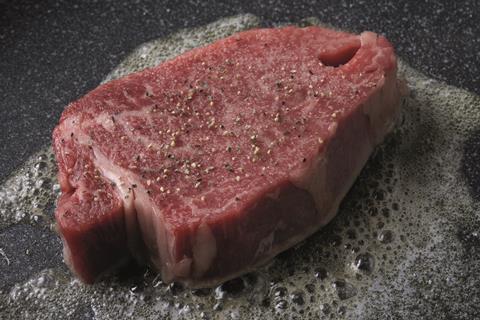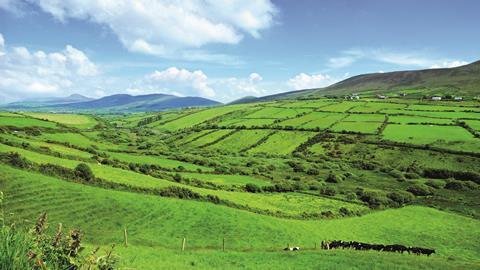Despite ongoing cost pressures, Irish food exporters are expressing optimism for robust market growth in 2024 - as JP Garnier reports.
Following years of steady growth, the dynamic Irish food sector has hit what appears to be a temporary snag. The country’s economy shrank by 3.2% in 2023, following the extraordinary growth period from 2017 to 2022 when GDP grew by an average of 9%. Consumers in the Republic, the EU and the UK are ‘feeling the pinch’ due to inflationary pressures. The livestock sector also faces higher input prices, an increasing regulatory burden and bureaucracy. With incomes falling, Irish farmers have held demonstrations in every county in February, in parallel with protests in other EU countries. Outside the EU, Irish meat is facing increasing price competition.
Challenging times for Irish exports
In 2023, Irish food exports fell for the first time in many years to €16.3 billion (£13.9 billion), a drop of 4% according to Bord Bia. The fall is largely attributed to lower international milk prices.
The country also faced a loss of competitiveness due to higher labour and input costs, including fertiliser and energy, a story not dissimilar to the UK.
Total meat exports also fell by 1% to €4.2 billion (£3.6 billion) in 2023. Smaller cattle throughput, down 2%, and lower carcase weights due to poorer grazing and lower feed usage contributed to a 3% decrease in the volume of beef exported to 489,000 tonnes. Cost-of-living pressures affected beef sales in the EU with beef perceived as expensive. Accordingly, sales of forequarter beef were strong, steak cuts less so.

Third Country exports also fell by 20% due to the competition from cheaper Australian beef in Asia. However, the visit of Taoiseach to China this January led to the resumption of beef exports. Between April and October 2023, Ireland exported €25 million of beef as the market was reopened.
For lamb, tight supplies in the second half of the year and poorer carcases due to climatic conditions contributed to a fall of 7% in export value to €440 million. France remains the main destination for Irish lamb.
In 2022-23, Irish pig farmers reduced their herds in response to higher costs of production, a reaction similar to other EU producers. According to Teagasc, margin over feed in 2022 was the lowest in 40 years. Consequently, the number of Irish pigs slaughtered decreased to 3.48 million in 2023, a fall of 360,000 pigs (-9.3%), and exports decreased by 17% in volume and 20% in value. In the second part of 2023, pig producers returned to profitability and some stabilisation of volume is expected in 2024. The Asian market will remain subdued.
Poultry production and exports expanded in 2023 due to strong domestic and EU demand. Export value was up 7% at €170 million.
The UK, the essential market for Irish food
The UK continues to be Ireland’s most significant export partner representing 34% total food exports, worth €5.6 billion (£4.8 billion) in 2023, up 16.7% on 2022 levels. Bord Bia emphasised the surge in Irish beef exports to the UK, reaching an estimated €1.4 billion (£1.2 billion), up 10% year-on-year, giving a share to 47% of total beef exports, up from 44% in 2022. The corporate overlap, where major Irish processors are also the main players of the British beef sector is an enduring feature of this large trade.
Bord Bia’s EU & UK consumer survey reports a rising British interest for Irish origin of steaks (47%, up 4% in Q2 2023 against Q2 2022) and burgers (36%, up 6%).
Pork exports to the UK increased by 41% to approximately £113 million reflecting tight UK supplies.
Bord Bia will carry on investing in Britain to maintain a strong presence on its major historical beef market. For instance, St Patrick’s Day represents a key opportunity to showcase Irish produce. Over 50,000 people were present at the London’s Lord Mayor official St. Patrick’s Day consumer event at Trafalgar Square. Outside the UK, Irish beef was also presented in Italian restaurants, French supermarkets and in the prestigious German Galeria Markthalle food halls for the annual event. The Irish Beef Club recently celebrated its 20th anniversary and now involves over 90 Michelin star and award-winning chefs, many of them in Britain.
In 2023, Irish sheep meat exports to the UK have remained constant at 16% in value, worth £70 million. Pork exports to the UK increased by 41% to approximately £113 million reflecting tight UK supplies. The UK is also the main market for added value pork products such as cooked bacon, toppings and ingredients for quick service and processed foods. This trade, often underreported, represented about £255 million in 2023 (up 2% against 2022). Similarly, the UK is the principal outlet for added value poultry, mainly cooked chicken, a trade worth last year £145 million (down 2%). Exports of burgers to the UK also account for a large share of total exports of processed beef.
The trade from the Republic of Ireland to Northern Ireland for live slaughter cattle and pigs remains very large at £134 million.
In short, despite growing sales to the EU and further afield and the Brexit trauma, in difficult times such as 2023, there has been some return to tighter trade relations between the Republic of Ireland and Britain.

Impact of cost-of-living pressures
Bord Bia EU consumer research confirms that the stark impact of inflation on meat purchases have started to ease in Ireland. Still, in 2023, 17% of Irish people perceived beef as too expensive, less so than in the UK where 30% agreed with the statement. In the two countries, the cost of beef remains the single most important barrier to purchase.
Despite price sensitivity, Irish steak sales rebounded in 2023. Moreover, the image of beef is improving. For example, 75% of Irish people agree with the statement “Beef is a protein that is worth paying for” (68% in the UK); 90% subscribe to the declaration “I think beef tastes great; it’s a real treat” (88% in the UK).
Out of home expenditure is forecast to increase by around 5% in 2024 rising from €9.3 billion to €9.8 billion (£8 billion - £8.4 billion).
According to an analysis commissioned by the Irish Food Board, the food service sector was up nearly 13% in 2023 across the island of Ireland. This is the first time that the market value has exceeded pre-pandemic levels. Out of home expenditure is forecast to increase by around 5% in 2024 rising from €9.3 billion to €9.8 billion (£8 billion - £8.4 billion). Still, cost-of-living pressures are impacting consumer behaviour with a fall of frequentation and some trading down, such as choosing fewer and cheaper dishes. Some 65% of Irish shoppers admit “I purchase nicer foods to consume at home at the weekend instead of eating out” (58% in the UK).
Never mind the small 2023 export set back. According to a recent exporters’ poll by Bord Bia, the stakeholders best placed to consider what lays ahead, the industry remains undeterred, with 73% of Irish food and drink exporters expressing optimism for robust market growth in 2024.





















